

 |
April 5, 2018: A Tour to the DMZ |
 |
Return to the Index for Our Visit to Seoul |
Today, we are scheduled for a Seoul City Tour, again with Viatour. Our pickup is at 9AM, and the tour is billed as one of the best to include Gyeongbokgung Palace. Our pickup at the Ibis was right on time, and the small van took us over to Jogyesa Temple- the meeting point with our tour guide and the rest of the members of our tour.
|
The tour itself will begin with our hotel pickup, and the first stop will be about ten blocks west at the Jogyesa Temple, where we will spend about an hour. Then our tour bus will pick us up and take us eight blocks or so northwest to the main gate of Gyeongbokgung Palace to begin a two-hour walkthrough of the palace complex.
Leaving the complex by the north gate, we'll see the Blue House (Presidential residence) from a distance, and then head down to the Presidential museum. Next will be a "shopping opportunity" at a ginger factory, and finally the tour will drop us back in the center of town in Seoul Plaza near the Chosun Hotel.
From there, Fred and I took a subway back up to Insadong and the Ibis, going out one more time to walk north to the Donhwamun Gate- entry to another of Seoul's ancient palaces. Walking back down to the Ibis, our last full day in Seoul will end with another dinner and a quite good Korean restaurant just across from the Ibis Hotel. With all that said, let's head off on our tour.
The Jogyesa Temple
Jogyesa is located in Gyeonji-dong, adjacent to Insadong here in downtown Seoul. Jogyesa is the chief temple of the Jogye Order of Korean Buddhism. The temple was first established in 1395, at the dawn of the Joseon Dynasty; the modern temple was founded in 1910 and initially called "Gakhwangsa". The name was changed to "Taegosa" during the period of Japanese rule, and then to the present name in 1954. Our tour gathered first underneath an entry pagoda near the street, a hundred feet or so from the actual temple.
|
|
After the introductions, she began talking to us about Jogyesa, and one of the first things we found out was that the open pagoda under which we were standing is, of course, relatively new; it is a reconstruction of the original "one pillar gate". The Jogye Order is the representative order of traditional Korean Buddhism with roots that date back 1,200 years to Unified Silla National Master Doui, who brought Seon (known as Zen in the West) and the practice taught by the Sixth Patriarch, Huineng, from China about 820 C.E. The name of the Order, Jogye, was adopted from the name of the village where Patriarch Huineng's home temple is located. The Jogye "sect" arose in the late 11th century as a combination of the Seon school with sutra-based Buddhist schools. The sect grew steadily over the centuries (although the number of its members has leveled off in this century). At the height of its influence and popularity in the mid-1990s (and it has declined only marginally since then) it managed 1,725 temples staffed by and housing 10,056 clerics. The sect currently claims over 9.1 million adherents.
|
|
As it now stands, Korean Buddhism is represented by the Jogye and Taego Orders. The attempt to harmonize belief has been only partially successful; Korean Buddhism still reflects the Seon and other Mahayana traditions that incorporate the Chan and Zen teachings. Korean Buddhism has contributed much to East Asian Buddhism, a belief system that I freely admit I understand very little. But Korean Buddhism is very much respected throughout East Asia.
The decoration of this gate was pretty amazing. I wondered if the little multi-colored paper lanterns had lights in them (the would have to be artificial, I assume), but I didn't ask. At any rate, here are more pictures of the "One Column Gate":
 (Click on Thumbnails to View) |
We came through the gate, following our guide up to the level of the actual temple, and a wide, gravel-covered area. In the upcoming pictures, you will see a huge additional number of these "lanterns", and I did ask our guide about them, finding out that the temple grounds were being decorated for Buddha's birthday.
|
It is a reconstruction of an earlier building (of which there have been a great many on this site) and we will look more closely at it shortly. You can also see in this picture two trees- each of which are over 500 years old. The tree at left is a Chinese Scholar tree (more about it shortly), and the one in the foreground is a White Pine.
Our guide paused us for some additional information (including the admonition that if we chose to enter the Buddha Hall we would need to take off our shoes and put away our cameras) and then turned us loose for the next three-quarters of an hour.
|
You may not have seen it clearly in the movie, but on the south side of the grounds, past the Chinese Scholar tree, there is a tall monument with a fountain at its base. We walked over in that direction to stand next to the Chinese Scholar tree and look up at the thousands of paper lanterns.
The birthday festival, designated Korea's Important Intangible Cultural Property No. 122, takes place in late April or early May each year. The origin of the three-day festival dates back 1,300 years, when the festival of Yeondeunghoe was held on a day celebrating the first full moon of the lunar calendar. During the Goryeo Dynasty (918-1392), that event turned into a festival marking Buddha’s birthday.
Lanterns featuring lotus and other traditional figures and objects representing people’s wishes are hung all through April, and those are what we are looking at here. The highlight of the three-day-long celebration will be the Lotus Lantern Parade, which winds along Jongno Street from Dongdaemun Gate to Jogyesa Temple. With thousands of participants, each carrying their own lantern, the parade becomes a river of light flowing through the heart of Seoul.
|
All the lanterns strung around the complex were amazingly colorful; we enjoyed them immensely and took quite a few pictures of them. Here are five of those pictures:
 (Click on Thumbnails to View) |
In the leftmost picture above, you can see the ancient White Pine tree; as it turns out, that tree is actually Korean Natural Monument No. 9!
The two major buildings here on the grounds (not counting the Iljum Gate) are the Buddha Hall and what seemed to be a building used by the Jogye Order; that second building was situated behind (to the west of) the Buddha Hall. When we turned to have a look at the Hall, we were on the side faced by the Buddhas inside; this side of the building had glass windows so that those not wishing to go inside could still look in and see the large statues:
 |
 |
The Buddha Hall was the most intricately-decorated building in the complex; every square inch of the exterior and the underside of the pagoda roof was decorated with colorful carved panels; many of them were based on nature- cherry tree branches, vines, fruit, and the like. You can see a closeup of one of those panels here. Jogyesa features a mix of traditional temple and palace architecture. The lattice designs found on the doors and windows of the Daeungjeon are unique in their own right. Other elements of the complex are the Beomjongnu, a structure where a bell which enlightens the public with its sound is housed, and an information center for foreigners.
|
It was very interesting to spend an hour wandering around this complex. I told Fred that it reminded me very much of the time I took a train north from Tokyo to visit the town of Chuzenji, and the incredibly beautiful shrine nearby. The decoration there exceeded the decoration here only due to the long rows of Cryptomeria trees and the snow-covered landscape, which set off the decoration of the shrine buildings more than urban Seoul sets off the decoration here.
|
|
|
At right are a couple of pictures taken around the west side of the Buddha Hall. Fred thought the contrast between the large number of paper lanterns provided an interesting contrast to the single large stone one. In my picture, I think that the building (as intricately-decorated as all the others) behind Fred is the center devoted to administration and information for visitors.
|
As we walked through the Iljum, Fred got a good closeup of one of the intricate carvings at either end of that structure.
When we'd all gatherered, our guide took us across the street to await our large tour bus. On the other side of the street, I realized that the building west of the Buddha Hall was not the center for information for foreigners that our guide had mentioned; we were actually standing in front of that building.
There was also a rather humorous figure holding a placard that mentioned something called "Temple Stay" and so I asked our guide about it. It turns out that "Temple Stay" is a cultural program which anyone can experience the life of buddha practitioners and also learn about the cultural knowledge transmitted throughout Korean Buddhist history. The temple stay of Jogyesa consists of various activities related to Korean tradition and buddhism (and while our guide didn't say so, I assume the program involves being able to stay on the temple grounds somewhere). Participants can experience Buddhism and talk with Buddhist practitioners, learning how to "control their minds and become totally introspective- achieving inner peace and learning how to be happy".
Gyeongbokgung Palace
The place where we will be spending most of our time today is Gyeongbokgung Palace- the main royal palace of the Joseon dynasty. Built in 1395, it is located in northern Seoul, about eight blocks northwest of Jogyesa, and is the largest of the Five Grand Palaces built by the Joseon dynasty. It served as the home of Kings of the Joseon dynasty, the Kings' households, and the government of Joseon.
|
I wonder sometimes why this is happening. Why would any map website wish to replace the high-resolution aerial views that they already had with views that are demonstrably less good? This would be particularly nonsensical if the area had not actually changed, or had not changed enough to justify the expense of an updated view. I can, of course, understand why new views of, say, downtown Fort Lauderdale, are needed. The downtown area of that city, particularly the area around my condo there, is dramatically different today than it was when I first visited in the early 1990s, and used aerial views on the album pages for that visit.
So this must mean that the aerial views taken by satellite and provided to us (and by "us", I mean Google, Bing, Mapquest, and so on, who put them online for the rest of us to make use of) are intentionally not as good as they once were. Certainly technology has not gone backward; certainly the satellites taking these pictures are not less capable than they used to be. The answer must be, and I hate to sound conspiratorial here, that someone has decided that it is not a good idea to provide such excellent resolution anymore- at least not to private citizens. (Again not wishing to sound conspiratorial, but I am sure that governments, the military, and the various world security services are still receiving aerial views at least as good (and probably much better) than they used to be.) So I apologize that the views on this page, many of the pages in the recent past, and probably all of the upcoming pages are not so good as they used to be. Certainly I wish they were, but until and unless I become another Elon Musk, and can orbit my own satellite, I doubt very much that they will be.
(as seen from the Outer Court) |
In the early 20th century, much of the palace was systematically destroyed by Imperial Japan before and during World War II. Since the end of that conflict, the walled palace complex has been gradually reconstructed to its original form. Today, the palace is arguably regarded as being the most beautiful and grandest of all five palaces. The Gyeongbokgung complex consists not only of the palace and its restored building, but also the National Palace Museum of Korea and the Korean National Folk Museum.
It did not take our bus long to bring us to the front (the south end) of the complex, outside the Gwanghwamun- the main and south gate of the complex. This gate fronts on a busy street, and so we had to alight quickly and gather around our guide. She gave us some first information about the complex, but wanted to usher us inside right away so that we would not miss the next scheduled "changing of the guard" ceremony.
The Gwanghwamun Gate
|
Gwanghwamun was reconstructed in 1867 along with the rest of Gyeongbokgung Palace by the order of regent Daewongun during the reign of Emperor Gojong. The gate stood until 1926, when the Japanese government had it deconstructed and moved it just to the southeast of the current location of the National Folk Museum of Korea to make way for the massive Japanese Governor General Building.
The Korean War completely destroyed the wooden structure of Gwanghwamun, and its stone base lay in complete disrepair and neglect. In 1968, during Park Chung-hee's administration, the stone base was again relocated in front of the Japanese Governor General Building. The destroyed wooden structure was rebuilt in concrete, while the sign on Gwanghwamun was written in hangul by Park himself. Gwanghwamun remained as a concrete gate until late 2006.
Gwanghwamun's most recent restoration began in late 2006; that project was finished in August 2010. The gate was disassembled and moved back to its original location, and its wooden structure was again reconstructed in wood. It was rotated in order to accurately place the gate to its original location, which perfectly aligns it with the main north-south axis of Gyeongbokgung Palace.
|
The $25 million project resulted in Gwanghwamun being reopened to the public on August 15, 2010, on Gwangbokjeol (Korean Liberation Day). A new name plate on the restored Gwanghwamun was unveiled on the same day. The name on the plate was based on Hanja lettering by Im Tae-young, the general in charge of the rebuilding programme by King Gojong of Joseon, written against a white backdrop framed by Dancheong traditional coloring.
|
Our guide also told us what we thought was a humorous story (based on on unfortunate event) that gave evidence that Koreans take their culture seriously (something I'd already known from my time in-country). Only a couple of months after the name plate was dedicated, a long vertical crack appeared. The dry autumn weather was blamed for causing the wood to contract, but experts differed on whether an an immature pine board was used to meet the deadline for completion or that the wood had not dried properly. A repair to the cracks was made, but the Cultural Heritage Administration decided to replace it. 13 wooden boards for the new sign were cut and underwent a natural drying process in Gangwon Province. However, a controversy arose over whether the calligraphy should be in the original 1395 Hanja style or the more modern Hangul. The public actually voted, but even though a majority opted for the more modern style, a majority of experts consulted thought the sign should be carved as the original had been.
|
In any event, we were in a perfect position to watch this "posting of the guards" and so I decided to make a movie of this part of the ceremony. You can use the player at left to watch the movie that I made.
When the short posting ceremony was complete, our group was able to head in to the large open area between the main gate and the first actual palace gate. This area is open to all visitors, even without a ticket to the palace itself. Fred snapped a picture of an impressive sculpture as our group start in.
Once most of our group had filed inside, I had a clear view of the guards that had been newly posted, so I thought I would take a few pictures.
|

Coming now into the open area, we could look back at the inside of the Gwanghwamun Gate, and here I found some things of interest. The first was that as I came through the gate and looked at it from the inside, it looked very familiar to me, obviously because I must have been here before.
|
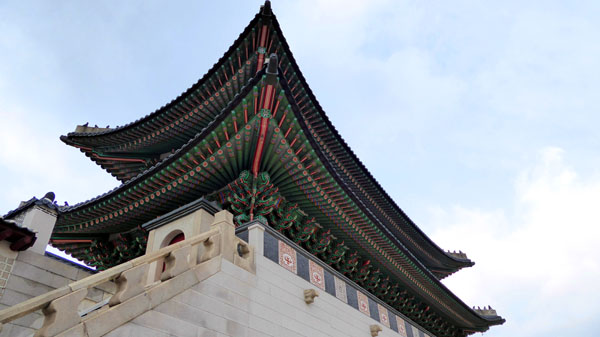
In looking through my pictures from 1970, I noticed something else relating to one of my pictures then and one of our pictures now. I find these kinds of parallels interesting, and I'd like to show you what I found.
|
If you will look just to the right in the picture, you will see a modern skyscraper that seems to be about 20 stories tall. When I looked at Fred's picture, I thought it was just another new building here in the much-more-modern Seoul, compared to the city I visited in 1970.
But when I was looking through some of the pictures that I took some 50 years ago, I discovered why I felt that something was familiar. I also discovered exactly how old the skyscraper actually is. You will see what I mean if you simply click on the skyscraper in Fred's picture.
Yes, I happened to take a picture of that same building in 1970, and you can see from the scaffolding that the building is just then being completed!
The Changing of the Guard Ceremony
|
Generally, the ceremony started with a drum announcement, and you can use the player below, left, to watch Fred's short movie of that segment below,. Next, the new guards, accompanied by other costumed people, enter the area from the Geonchunmun (East Gate). They are carrying flags and swords and are colorfully costumed.
There was a point where the procession stopped, and I could get a picture of the figures at the head of the procession. These were the replacement guards for those that we saw stationed at the south gate when we came in.
These procession continued towards the center of the area. We could see that in the procession were replacement guards equal in number to those we saw position themselves inside and outside the south gate earlier. When these guards were all inside the courtyard, they, and some additional figures that were accompanying them, went through a marching procedure and I found interesting. It was almost like a half-time display by a marching band at a football game (although much, much smaller). I made a movie of that procedure, and you can watch it with the movie player below, right.
|
|
The procession went to the middle of the courtyard and then turned the corner to the south so they were facing the south gate. At that point, the guards at the head of the procession continued on to the south gate, replacing the guards currently there. (Since we were inside the gate, we couldn't really see that procedure, but I assume it was modeled on something like the changing of the Guard at Buckingham Palace. We could see that the guards that were replaced, formed up and began marching north into the courtyard to become part of the procession that was still there. During this part of the ceremony, Fred was taking some pictures of the participants and of the courtyard and its gates (including a lone figure that I missed standing on the balcony at the south gate). You can see some of his pictures below:
 (Click on Thumbnails to View) |
Another element of the procession, aside from the replacement guards, was a group of musicians- composed of horns and drums- that also came in from the east gate and moved to the center of the courtyard. You saw some of these musicians in one of Fred's movies above, but here they are again:
|
|
Once the guards had been "retrieved" from the South Gate, the procession formed up again and moved to exit the courtyard- once again via the East gate.
|

(Click on Thumbnails to View) |
When the crowd disbursed at the end of the ceremony, our tour group got back together and our guide led us on into the palace complex.
The Heungnyemun (The Second Inner Gate)
|
When the Japanese built the General Government Building here in 1926, Heungnyemun was removed along with most of the other buildings and structures found at the palace. Between 1995 and 1996, the General Government Building was dismantled and removed in an effort to remove any trace of the Japanese occupation.
In 2001, Heungnyemun Gate, and its surrounding cloisters were rebuilt and restored to its original specifications. Taking photos with the guards is a popular tourist pastime, and there are almost always guards at this gate, and of course there are usually guards out front of the palace complex at the Gwanghwamun Gate.
Our guide gave us our individual tickets, and we all filed through this gate; on the other side, I took a picture of Fred and the Heungnyemun Gate. All day here at the palace Fred and I saw lots of Koreans in traditional garb; I didn't find out until later that wearing traditional clothing gets you into the Palace free. Walking towards the third gate through the Outer Courtyard, one crosses a wide bridge over a kind of moat, and there were lots of cherry trees in bloom. Here are two more good picture we took in the Outer Courtyard:
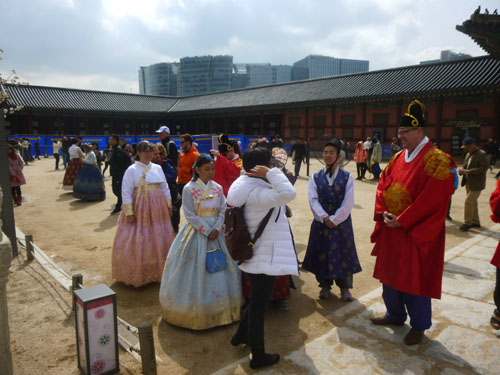 Visitors in Traditional Korean Garb |
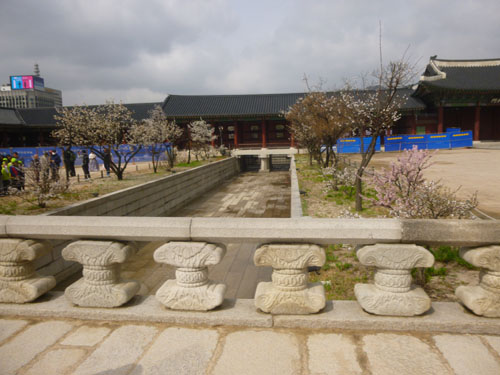 Moat and Cherry Trees |
The Geunjeongmun (The Third Inner Gate)
|
| |||
| Cherry Trees in the Outer Courtyard in Gyeongbokgung Palace | ||||
There are no gates on the east and west of this Outer Courtyard, as there were on either side of the public space inside the main gate on the south. The area was entirely enclosed by long low buildings, with gates through them on the south and north.
|
 (Click on Thumbnails to View) |
After our guide had given us an introduction to many of the structures we might look at, she turned us loose for the next 90 minutes for us to go have a look at whatever interested us. What I will do for the next group of pictures is just organize them by structure- putting all of our pictures of the same building together.
The Geunjeongjeon (The Throne Hall)
|
Here are three pictures that we took of Geunjeongjeon from just inside the Geunjeongmun Gate:
 (Click on Thumbnails to View) |
Constructed mainly of wood, Geunjeongjeon sits on the center of a large rectangular courtyard, on top of a two-tiered stone platform. This two-tiered platform is lined with detailed balustrades and is decorated with numerous sculptures depicting imaginary and real animals, such as dragons and phoenixes. Here are a couple of pictures Fred took as we climbed onto that platform:
|
|
The stone-paved courtyard is lined with two rows of rank stones, called "pumgyeseoks", indicating where the court officials are to stand according to their ranks. The whole courtyard is fully enclosed by wooden cloisters. The Geunjeongmun Gate is aligned with and located directly to the south of Geunjeongjeon, is the main gate to the courtyard and to Geunjeongjeon. The gate is divided into three separate aisles, and only the king was allowed to walk through the center one.
|
Gyeongbokgung was originally constructed in 1394 by King Taejo, the first king and the founder of the Joseon dynasty, and its name was conceived by an influential government minister named Jeong Do-jeon. Afterwards, the palace was continuously expanded during the reign of King Taejong and King Sejong the Great. It was severely damaged by fire in 1553, and its costly restoration, ordered by King Myeongjong, was completed in the following year. However, four decades later, the Gyeongbokgung Palace was burnt to the ground during the Japanese invasions of Korea of 1592-1598. The royal court was moved to the Changdeokgung Palace. The Gyeongbokgung palace site was left in ruins for the next three centuries.
As beautiful as the outside of the building was, the decoration inside the throne room was just as attractive. Each tourist took his turn at the open window in the center to look inside; I took a series of three photos and put them together into this image:

I took a separate picture of the audience hall ceiling to illustrate the extent of the interior decoration. This building, not surprisingly, was designated as Korea's National Treasure No. 223 (in 1985).
|
To get to the Queen's chambers, we walked around the west side of Geunjeongjeon Hall; here are some views of the structure from that angle:
 (Click on Thumbnails to View) |
In 1867, during the regency of Daewongun, the palace buildings were reconstructed and formed a massive complex with 330 buildings and 5,792 rooms. Standing on more than 125 acres of land, Gyeongbokgung again became an iconic symbol for both the Korean nation and the Korean royal family. In 1895, after the assassination of Empress Myeongseong by Japanese agents, her husband, Emperor Gojong, left the palace. The Imperial Family never returned to Gyeongbokgung.
|
While we were here at Geunjeongjeon Hall, we took a number of pictures of the colonnades that surround the Hall on the west, north, and east (the entry gate is on the south):
 (Click on Thumbnails to View) |
The Gangnyeongjeon (The King's Residence)
|
 (Click on Thumbnails to View) |
The King's Residence was reached through a small gate from the audience hall. Here on this side of that gate there were, in addition to the residence, numerous smaller buildings with intricately constructed roofs
Gangnyeongjeon consists of corridors and fourteen rectangular chambers, each seven chambers located to the left and right side of the building in a layout out like a checkerboard. The king used the central chamber while the court attendants occupied the remaining side chambers to protect, assist, and to receive orders. The building rests on top of a tall stone foundation, and a stone deck or veranda is located in front of the building.
|

(Click on Thumbnails to View) |
Gyotaejeon (The Queen's Residence)
|
The pictures below show the inside of the Gyotaejeon, and here is a closeup view of the ceiling decoration.
 (Click on Thumbnails to View) |
Like so many other structures here in the palace, this building was also burned down in 1592 when the Japanese invaded Korea, but it also was reconstructed in 1867. Nevertheless, when Daejojeon of Changdeokgung Palace was burned down by a fire in 1917, the Japanese government disassembled the building and recycled its construction materials to restore Daejojeon.
The current building was reconstructed in 1994 according to its original design and specifications. The building, like Gangnyeongjeon, does not have a top roof ridge (yongmaru).
Gyeonghoeru Pavilion
| ||||||||
Constructed mainly of wood and stone, Gyeonghoeru has a form where the wooden structure of the building sits on top of 48 massive stone pillars, with wooden stairs connecting the second floor to the first floor. The outer perimeters of Gyeonghoeru are supported by square pillars while the inner columns are cylindrical; they were placed thus to represent the idea of Yin & Yang. When Gyeonghoeru was originally built in 1412, these stone pillars were decorated with sculptures depicting dragons rising to the sky, but these details were not reproduced when the building was rebuilt in the 19th century. Three stone bridges connect the building to the palace grounds, and corners of the balustrades around the island are decorated with sculptures depicting twelve Zodiac animals.
Other Buildings and Scenes Within the Inner Court
|
|
But as with any visit to a site like this one, there were quite a few candid shots of this thing or that, or of a scene that had something odd (or pretty, or amusing) about it, and those are the pictures I've chosen for the slideshow at right.
I hope you'll look through these pictures that we took. As with all the slideshows in this album, you can move from picture to picture using the little arrows in the lower corners of each image, and you can see where you are in the show by referring to the index numbers in the upper left of each picture.
Enjoy!
We left the Inner Courtyard through a small gate in its northwest corner. As we were walking up that path, we passed a pair of women in traditional dress. Once through the gate, we walked north along a broad path into an area of gravel paths, trees, lawn, and water features. As we walked, we could look back at the Inner Courtyard.
The Palace Gardens
|

(Click on Thumbnails to View) |
In the pictures above, you can see a two-story hexagonal pavilion; this is the Hyangwonjeong, built around 1873 by the order of King Gojong. The pavilion was constructed on an artificial island in a small lake named Hyangwonji; connecting it to the rest of the palace grounds is a bridge named Chwihyanggyo. The name Hyangwonjeong is loosely translated as "Pavilion of Far-Reaching Fragrance", while Chwihyanggyo is "Bridge Intoxicated with Fragrance".
The bridge Chwihyanggyo was originally located on the north side of the island and was the longest bridge constructed purely of wood during the Joseon dynasty; however, it was destroyed during the Korean War. The bridge was reconstructed in its present form on the south side of the island in 1953, but is now being relocated to its original location on the northern side. The reconstruction is expected to be completed in 2019. When I got to the top of the small hill, I made a panoramic picture of the view to the east and south, in which you can see the whole of the artificial lake:
 |
The Jibokjae (Private Royal Library)
|
The building uniquely shows a heavy influence of Chinese architecture instead of traditional Korean palace architecture. Its side walls were entirely constructed in brick, a method commonly employed by the contemporary Chinese, and its roof formations, interior screens, and columns also show Chinese influences. Its architecture possibly was meant to give it an exotic appearance.
Jibokjae is flanked by Parujeong, an octagonal two-story pavilion, to the left and Hyeopgildang to the right. Parujeong was constructed to store books, while Hyeopgildang served as a part of Jibokjae. Both of the buildings are internally connected to Jibokjae.
Bohyeondang and Gahoejeong, buildings that also formed a library complex to the south of Jibokjae, were demolished by the Japanese government in the early 20th century. This was such a neat area, and it was so open, that it was an excellent place for a panoramic view. I've constructed one that includes not only the Jibokjae, but all the buildings and walls on either side of it. That view is in the scrollable window below:
 |
Sinmumun (The North Gate)
|
We left Gyeongbokgung through this gate, and eventually walked west along the street on the north boundary of the palace complex. A little ways down the street, we got a nice view of the outside of the Sinmumun. Our visit to the palace concluded here, but the next stop on our list was right in front of us.
The Blue House
Our tour did not actually go to the Blue House, but we were able to see it from a distance. (It was like having a tour of Washington that didn't include a tour of the White House).
|
Built upon the site of the royal garden of the Joseon Dynasty (1392–1910), the Blue House now consists of the Main Office Hall, the Presidential Residence, the State Reception House, the Press Hall, and the Secretariat Buildings. The entire complex covers approximately 60 acres on a site recently named Cheong Wa Dae.
Cheong Wa Dae was the site of a royal villa in what was then Hanyang, the southern capital of the Goryeo dynasty (918–1392). It was built by King Sukjong in 1104. Goryeo's principal capital was at Kaesong, and it also maintained a western capital at Pyongyang and an eastern capital at Gyeongju.
|
With the establishments of the Republic of Korea in 1948, President Syngman Rhee used the building as his office and residence. President Yun Bo-seon changed the name to "Cheong Wa Dae" after he was inaugurated in 1960. Presidents since then have used the Blue House as both as their office and official residence. While President Roh Tae-woo was in office, a new office building, official residence, and press center, called Chunchugwan, were built. The main office building was opened in April 1991.
This was as close as we got to the Blue House; our tour guide led us down to our left along Cheongwadae-ro ("ro" means, generally, "avenue") to a small plaza at the intersection with Hyoja-ro.
|
In the middle of the large intersection there is a statue of a phoenix, surrounded by statues of families, proclaiming the message that Korea has risen from the ashes of war and now hopes for peace.
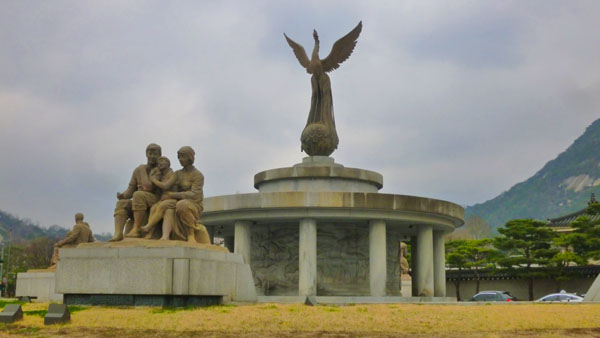
From the plaza in front of the Presidential Museum, we took a number of pictures looking across the Phoenix Monument towards the Blue House complex, and we could see another entrance to that complex. Here are some more views of the monument and those buildings, as well as some of the other tourists around and at least one person who seemed to be protesting or advocating something:
 (Click on Thumbnails to View) |
Just south of the plaza was the Cheongwadae Sarangchae- the presidential museum of South Korea. Just in front of it, we encountered another pair of the bears known as Soohorang and Bandabi. We had seen them all over Seoul; Soohorang is the official mascot of the 2018 Winter Olympics, and Bandabi is the official mascot of the 2018 Winter Paralympics- both events held here in Korea. Soohorang is a white tiger and Bandabi is an Asiatic black bear. "Sooho" means "protection" in Korean, symbolizing the protection offered to the athletes, participants and spectators at the Winter Olympics, as well as preserving the world peace that is the spirit of the Olympic Games. "Rang" derives from "Ho-rang-i", the Korean word for "tiger". "Banda" means "half-moon" or a "half-moon beast", and "bi" means to celebrate the competition. The mascot is a symbol of will and courage.
|
|
|
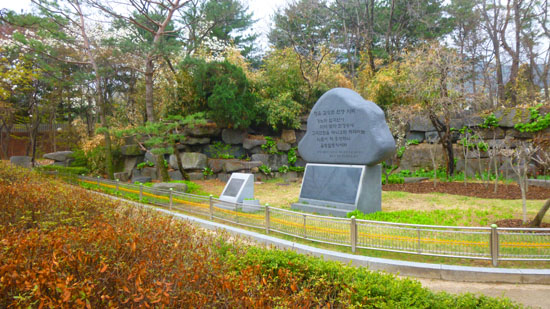
|
The last stop on our tour was a "shopping opportunity", thinly disguised as a visit to a ginseng factory. It was short bus ride from the Blue House, and it included a short lecture about the spice and its cultivation in Korea and elsewhere. Then there was a visit to a sales room where you could buy just about anything ginseng. The only picture I took was of a display of ginseng root. Oddly enough, right across the street from the "ginseng factory" there was another small Ibis Hotel.
Our tour returned us downtown about 4PM in the afternoon, dropping us at Seoul Plaza. We all thanked our tour guide and then went our separate ways. I wanted to walk around the area for a bit before heading back to the Ibis.
Seoul Plaza
When the tour let us off, we were pretty much in the center of the older part of downtown Seoul. The newer buildings, including Seoul's tallest, are just on the other side of the Han River, about a mile away.
|
Seoul Plaza is a central plaza located in front of the new Seoul City Hall at Taepyeongno, It was closed for two years beginning in 2002 for an extensive renovation, and reopened on 1 May 2004, by Seoul Metropolitan Government, with the purpose of providing the public an open space. It is part of the City's plans for environmentally friendly renovation projects.
The site was originally a traffic square with a 40-year-old fountain that was demolished and the nearby renovated in the early 1980s. The plaza is elliptical in shape, covering about three acres- two of those are an open grass area. In the most recent renovation, an underground water tank was installed along with 48 lighting units around the grass square. The underground tank stores rain water for use in the sprinklers on the lawn. Every winter since 2004, the Plaza has hosted an open air ice-rink from mid-December to February.
Here was another case where I found myself remembering sights from my tour of duty back in 1970, and, once again, I went to my pictures from those years and have found some interesting things. For example, Seoul Plaza used to be a traffic square; what that means is that there was a fairly rectangular traffic circle with parking in the middle. And there used to be a fountain here as well- the one demolished in the early 1980s. Both of these things are in my pictures from an afternoon I spent in the city:
|
|
Of course, all the surrounding buildings (except for the old City Hall, now a library, and the Chosun Hotel) have pretty much been replaced in the last 50 years, and I might not have associated my pictures from 1970 with this square if it hadn't been for the old City Hall and the hotel.
|
Of course, the very modernistic New City Hall appears, but it is hard to find any building in my 1970 picture that still appears in his picture from today; almost everything has changed. I suppose this is to be expected in the course of 50 years; there are only a few cities (Charlotte and Chicago are two that come to mind) that I visited or lived in between 1960 and 1970. In Charlotte's case, a recent visit showed me that only one or two buildings present in the downtown core in 1960 are still there (and both of these had been extensively remodeled or reconstructed). In the case of Chicago, there are actually a great many skyscrapers in the downtown core that are still there today, but most of these are lost in today's skyline.
Seoul is something of a special case, though. South Korea really only began to modernize extensively in the early 1970s; there were a couple of highrises and one expressway when I was there, but off the main streets the city was still a rabbit warren of small lanes and alleys- many of them unpaved. The modernization of Seoul began in the 1970s, but it didn't really take off until Korean companies like Samsung, Hyundai, and others became global powerhouses. (The same thing happened to Japan, albeit perhaps ten years earlier.) Seoul did a good job retaining cultural sites (like the palace we visited earlier) and classic buildings (like the old City Hall) and a few recently-built skyscrapers (like the Chosun Hotel), but almost everything else has been swept away and replaced. Seoul is simply not the city I once knew.
Here is a panoramic view of Seoul Plaza that I made this afternoon:
 A 180° View of Seoul Plaza |
Here are two more views of Seoul Plaza from this afternoon. The new fountain is one of those multi-vent, timed fountains, and is no longer in the center of the plaza, but off to the side- actually behind me in the right-hand picture below. The left-hand picture is of a old, small shrine that has been preserved across the street on the south side of the plaza.
|
|
The last similarity in this short trip down memory lane involves the Chosun Hotel. The hotel building was completed just as I arrived in-country in 1969, and it was one of the tallest buildings in Seoul. It was also the most opulent, and the first, luxury, Western-style hotel in the city. On one weekend afternoon on one of my jaunts down into Seoul, I stopped by to photograph it:
|
|
|
Knowing that, you can tell that the vantage point for the two pictures is different, but the building is the same. Sadly, I don't have a picture of the hotel that shows its position in the surrounding buildings, all of which have changed since I was there. But I always find these kinds of connections between past and present to be interesting- like seeing the old City Hall then and with the futuristic new City Hall behind it now.
Anyway, we walked around Seoul Plaza for a while, and then found an entry into the Seoul Underground (like many cities with metro systems, there is a whole underground city associated with it) so we could catch a train back to Insadong.
In Our Insadong Neighborhood
We found a subway entrance quite close to the Chosun Hotel, but we had to walk a quarter mile through an underground arcade to actually reach the metro, where we bought our tickets back to the stop near the Ibis Hotel. The Seoul Metro is constructed a little differently than the ones we've used here in the States and elsewhere. Here (and in Germany, Prague, and Istanbul) when you are standing on the platform awaiting the train you could, if you were dumb enough, step off the platform and onto the tracks a few feet below. That is to say that there is no barrier between you and the tracks.
|
The station also had some interesting signs that we thought were interesting for one reason or another; here are some of them:
 (Click on Thumbnails to View) |
We took the Metro back to Insadong, and then walked once again through the maze of little buildings south of the Ibis Hotel. Walking through these areas reminds me of my time walking through the back streets of old Seoul- except that everything is paved and you can tell that all the little shops and stores have all the modern conveniences. Below are a still picture of Fred in one of the alleyways (left) and a movie I made as we walked through the area (right).
|
We went back to the hotel for just a while, and then decided to come back across the street to the same little Korean restaurant where we'd eaten last night to try something different. Again we had a really good meal, and it was very reasonable.
|
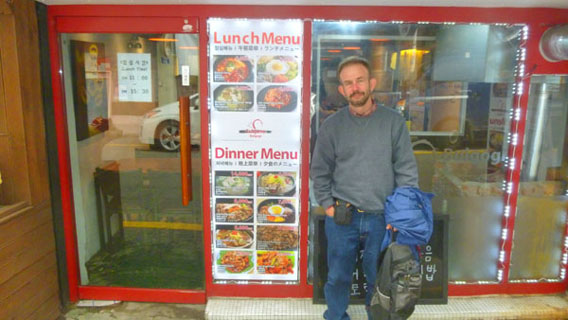
The Donhwamun Gate
It was still light out, so we thought that on our last evening we'd take a walk up to Changdeokgung Palace, about eight blocks north of the hotel. We wouldn't go through it, as it was already near closing, but we could at least take a look at its main gate. The name translates literally to "Prospering Virtue Palace"), and this palace, one of the "Five Grand Palaces" built by the kings of the Joseon Dynasty (1392–1897) is set in a large park.
|
|
Changdeokgung was the most favored palace of many Joseon princes and retained many elements dating from the Three Kingdoms of Korea period that were not incorporated in the more contemporary Gyeongbokgung. One such element is the fact that the buildings of Changdeokgung blend with the natural topography of the site instead of imposing themselves upon it. It, like the other Five Grand Palaces in Seoul, was heavily damaged during the Japanese occupation of Korea (1910–1945). Currently, only about 30% of the pre-Japanese structures of the East Palace Complex survive.
Today there are 13 buildings remaining on the palace grounds and 28 pavilions in the gardens, occupying 110 acres in all; the area is designated as Historical Site No. 122. Buildings of note include the Donhwamun Gate, a main hall, auxiliary offices, a private residence for the king, and other structures similar to those at Gyeongbokgung.
|
|
|
|
You can see that there are many more buildings than at Gyeongbokgung, and that it is also a lot less spread out with a lot less area devoted to open spaces. In that photograph, you can see the Donhwamun Gate in the lower right, and almost all of the palace complex. I thought that, not actually going in to the palace, this would be our best view of what it was like. As it turned out, I was wrong, for when we walked across the street to the west, we found a little elevated park (it is behind me in the photograph), and it was high enough that we could see over the wall surrounding the palace.
|
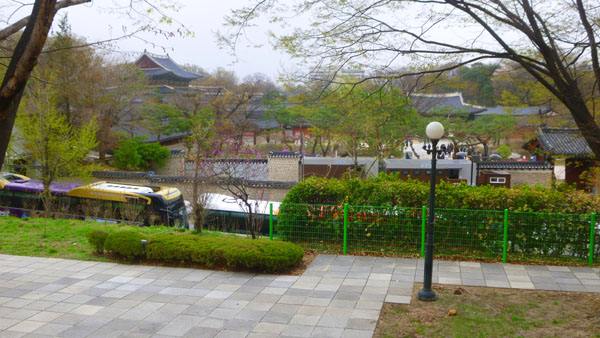
While I was taking those pictures, Fred used his zoom to get closer views of the buildings in the palace:
|
|
The park itself was very nice- a little oasis with nice views not only into the palace, but also to the north and west.
|
 (Click on Thumbnails to View) |
From here, we walked a block further west so we could cross the street to the south via a pedestrian crossing at a traffic light. Even though it was going on 6:30, the traffic was still quite heavy. Then we doubled back to the east to find a small street that would lead us south back to the hotel.
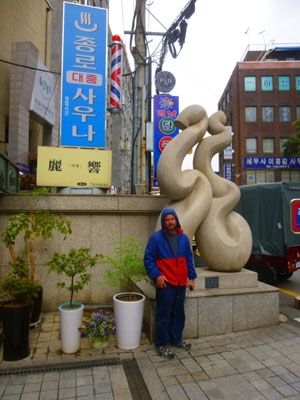 |
The street we walked down is above, and at the left and right are pictures of two sculptures we passed. One was in front of a small hotel a ways down the street we chose, and the red-and-silver sculpture was in front of the office building just to the west of the Ibis Hotel. |
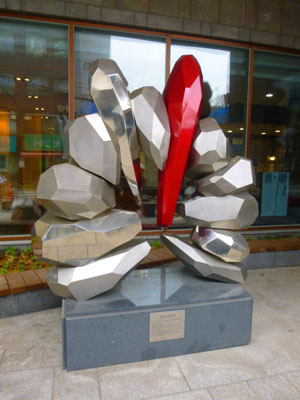 |
We came back to the hotel and worked on creating our daily update email for today's activities. We also went up to the rooftop garden to have a look around, and took a short walk across the street to see what the area was like at night. But we had to turn in early, as our taxi driver would be here at 6AM to take us to the airport for our flight to Singapore.
You can use the links below to continue to another photo album page.
 |
April 5, 2018: A Tour to the DMZ |
 |
Return to the Index for Our Visit to Seoul |